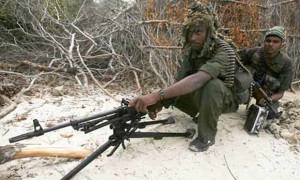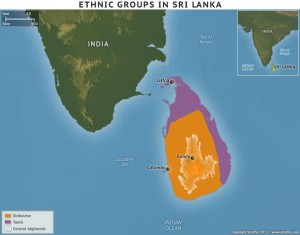Wcag Heading
by Samantha Subramanian
In conversations about politics in Sri Lanka, and therefore in conversations about the war and the peace, rumor forms the chief currency. Everybody appears to have their own particular runnels of information, flowing from indistinct sources. Even the newspapers, rather than investigating rumors, just transmit them onward through columns of political gossip. But in the absence of definitive fact, a certain measure of knowledge can be gleaned from the outskirts of hearsay. Perhaps, like real currency, rumor even keeps things liquid, because it does not always require you to commit to an opinion or to modify your views. During the war, this must have been a useful quality.

Image is in the public domain via TheGuardian.com
On buses and trains, in tea shops and on verandas, in Colombo and Jaffna and a dozen other places, the rumor mill never stopped churning. The momentous and the trivial were relayed with equal urgency. The Grease Yaka was just one man on the move, criss-crossing the country on his well- lubricated tour of terror. A former president, now long dead, used to insist on being bathed by virgins. The Tigers were rearming. Gillian Anderson, the actress from The X-Files, had bought a house just outside Colombo but was now reconsidering her decision because she felt the country was too unsafe. The government was repopulating the north and the east by moving thousands of Sinhalese families up from the south, settling them on farmland snatched from the Tamils. One of the president’s brothers had installed a tank full of sharks on his lawn. In the north, the army was abducting Tamils at random. In the north, the army was not abducting Tamils at random. The opposition was being paid off to lie low. Funds stashed overseas by the Tigers were being siphoned back into the country, and so the fighting would soon begin again.
When I had newly moved to Sri Lanka, in the gummy summer of 2011, this flood of rumor was disorienting: there was too much information and, at the same time, there was not enough. I learned, over months, to sieve what I heard, just as I learned to subconsciously note the precise moment when an innocuous chat broke away into a discussion of the war. It rarely took long, and that was not surprising. The Sri Lankans I met had lived most of their lives watching their country at war with itself. In Jaffna or in Batticaloa—the north and the east, which the Tigers had wanted to peel away from the rest of Sri Lanka—it was an abject impossibility to meet anybody who had not lost a friend or a relative in the prachanai. (The Tamil word translates into ‘the problem,’ which always reminded me of the Troubles, the Irish term for their own three decades of conflict.) In Colombo too, where the Tigers had executed countless attacks on civilians and politicians, and where security policy was made, the war hovered above every conversation, waiting to insinuate itself at the most slender of opportunities. The change of topic could happen imperceptibly, or it could happen abruptly.
‘India?’ somebody would ask me in Jaffna. ‘Where are you from, in India?’
‘I live in New Delhi,’ I’d reply.
‘But you speak Tamil.’
‘Yes, my family is from Tamil Nadu. I’m Tamil too. I grew up in Madras.’
‘Madras. I know Madras. I’ve been there. I went away to Madras to live with an aunt when the fighting got very bad around here. That was in 1987.’
And then we would be off.
It never required much to begin a conversation in Sri Lanka. The very air was primed for it. In a country so full of uncertainty, all life, and all death, was rehearsed through conversation. It was a form of art, well-honed and practiced with skill. Just as much information was solicited as given. Threads of thought spun out into fractals. Conversations became explorations, really, shifting and moving and pushing gently at the boundaries of their authors’ knowledge. Time, never in a hurry in Sri Lanka anyway, slowed down even further.
My friend Sanjaya was one of the masters of this art. He was a big man in every way—tall and broad and nearly bald, and then with a personality that was even larger than his physical frame. Sanjaya was an intermittent journalist, having studied briefly in Madras. He would work producing news documentaries for a few weeks, nose diligently applied to grindstone; then his pace would slacken, and he would play video games and watch movies for a couple of months. It was impossible not to like him. He was curious about everything, and he told yarns tall and magnificent, embellishing on the run and possessing such a fondness for the absurd that he giggled as if he were hearing the tale and not narrating it. When he laughed, his eyes narrowed into letterbox slits, he quivered noiselessly, and his shoulders heaved. His mirth was tectonic.
When I moved to Colombo, I first stayed with Sanjaya, in his family’s house on the outskirts of the city. We had several friends in common, but Sanjaya was also a popular point of first contact for journalists arriving in Sri Lanka. It was, I think, because of his eternal willingness to sit and swap stories, to examine all Sri Lanka and even all creation over a single bottle of beer. Journalists yearn for people like Sanjaya.

Image is in the public domain via stratfor.com
‘Come, we’ll go to Machang?’ he’d say, so we’d set out for the pub, which was owned by a brewing company and served its beer in tall plastic towers with a core of ice. A dour fog of smoke hung always in its rooms, and Sanjaya added to it with frequent, well-relished cigarettes. Around us, young men in tight T-shirts inhaled their beer and ate hot buttered cuttlefish and played pool.
‘So I met this guy in Mullaitivu, right?’ Deep drag. ‘He got 25,000 rupees because he was a refugee, and he’s set up a local cinema with it! He has a 25-inch television and a DVD player and a generator and 30 or 40 chopsocky movies from the 1980s.’ Silent laughter. Deep drag. ‘And during the day, he charges mobile phones on his generator. This is his living.’ Deep drag. ‘I wonder what the other refugees do with the money they get.’
This was how Sri Lanka sucked me in deeper and deeper: by discussing itself incessantly. The more I listened to Sanjaya, and then to others, the more the country and the history of its war revealed itself to me. A bigger, clearer picture always dangled just out of reach, around the corner of another conversation or two. Sanjaya made me realize that all I wanted to do was to wander around the island and talk about the one subject that everybody wanted to talk about. The war loomed too close to hand and too enormous for my senses to grasp it properly, like a wall that spread away to infinity in every direction. But in conversations, I heard stories of individuals—fantastic or tragic or melancholic or even happy stories, stories that had human proportions, and that could be multiplied in my head to gain a larger truth.
SAMANTH SUBRAMANIAN is a New Delhi-based writer and journalist. He is the author of This Divided Island: Life, Death, and the Sri Lankan War and has written stories for the New Yorker, Granta, The New York Times, and the Wall Street Journal, and book reviews and cultural criticism for the New Republic, the Guardian and Bookforum.
